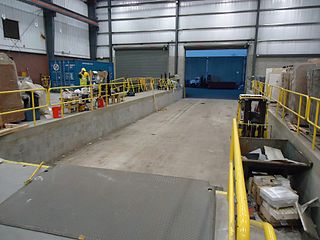Related Research Articles

In commerce, supply chain management (SCM) deals with a system of procurement, operations management, logistics and marketing channels, through which raw materials can be developed into finished products and delivered to their end customers. A more narrow definition of supply chain management is the "design, planning, execution, control, and monitoring of supply chain activities with the objective of creating net value, building a competitive infrastructure, leveraging worldwide logistics, synchronising supply with demand and measuring performance globally". This can include the movement and storage of raw materials, work-in-process inventory, finished goods, and end to end order fulfilment from the point of origin to the point of consumption. Interconnected, interrelated or interlinked networks, channels and node businesses combine in the provision of products and services required by end customers in a supply chain.

Logistics is the part of supply chain management that deals with the efficient forward and reverse flow of goods, services, and related information from the point of origin to the point of consumption according to the needs of customers. Logistics management is a component that holds the supply chain together. The resources managed in logistics may include tangible goods such as materials, equipment, and supplies, as well as food and other consumable items.

A supply chain, sometimes expressed as a "supply-chain", is a complex logistics system that consists of facilities that convert raw materials into finished products and distribute them to end consumers or end customers. Meanwhile, supply chain management deals with the flow of goods within the supply chain in the most efficient manner.

Distribution is the process of making a product or service available for the consumer or business user who needs it, and a distributor is a business involved in the distribution stage of the value chain. Distribution can be done directly by the producer or service provider or by using indirect channels with distributors or intermediaries. Distribution is one of the four elements of the marketing mix: the other three elements being product, pricing, and promotion.
A value chain is a progression of activities that a firm operating in a specific industry performs in order to deliver a valuable product to the end customer. The concept comes through business management and was first described by Michael Porter in his 1985 best-seller, Competitive Advantage: Creating and Sustaining Superior Performance.
The idea of the value chain is based on the process view of organizations, the idea of seeing a manufacturing organization as a system, made up of subsystems each with inputs, transformation processes and outputs. Inputs, transformation processes, and outputs involve the acquisition and consumption of resources – money, labour, materials, equipment, buildings, land, administration and management. How value chain activities are carried out determines costs and affects profits.

Reverse logistics encompasses all operations related to the upstream movement of products and materials. It is "the process of moving goods from their typical final destination for the purpose of capturing value, or proper disposal. Remanufacturing and refurbishing activities also may be included in the definition of reverse logistics." Growing green concerns and advancement of green supply chain management concepts and practices make it all the more relevant. The number of publications on the topic of reverse logistics have increased significantly over the past two decades. The first use of the term "reverse logistics" in a publication was by James R. Stock in a White Paper titled "Reverse Logistics," published by the Council of Logistics Management in 1992. The concept was further refined in subsequent publications by Stock (1998) in another Council of Logistics Management book, titled Development and Implementation of Reverse Logistics Programs, and by Rogers and Tibben-Lembke (1999) in a book published by the Reverse Logistics Association titled Going Backwards: Reverse Logistics Trends and Practices. The reverse logistics process includes the management and the sale of surplus as well as returned equipment and machines from the hardware leasing business. Normally, logistics deal with events that bring the product towards the customer. In the case of reverse logistics, the resource goes at least one step back in the supply chain. For instance, goods move from the customer to the distributor or to the manufacturer.

Demand-chain management (DCM) is the management of relationships between suppliers and customers to deliver the best value to the customer at the least cost to the demand chain as a whole. Demand-chain management is similar to supply-chain management but with special regard to the customers.
Competence-based strategic management is a way of thinking about how organizations gain high performance for a significant period of time. Established as a theory in the early 1990s, competence-based strategic management theory explains how organizations can develop sustainable competitive advantage in a systematic and structural way. The theory of competence-based strategic management is an integrative strategy theory that incorporates economic, organizational and behavioural concerns in a framework that is dynamic, systemic, cognitive and holistic. This theory defines competence as: the ability to sustain the coordinated deployment of resources in ways that helps an organization achieve its goals .> Competence-based management can be found in areas other than strategic management, namely in human resource management.
Quick response manufacturing (QRM) is an approach to manufacturing which emphasizes the beneficial effect of reducing internal and external lead times.

Supply chain risk management (SCRM) is "the implementation of strategies to manage both everyday and exceptional risks along the supply chain based on continuous risk assessment with the objective of reducing vulnerability and ensuring continuity".
Supply-chain sustainability is the impact a company’s supply chain can make in promoting human rights, fair labor practices, environmental progress and anti-corruption policies. There is a growing need for integrating sustainable choices into supply-chain management. An increasing concern for sustainability is transforming how companies approach business. Whether motivated by their customers, corporate values or business opportunity, traditional priorities such as quality, efficiency and cost regularly compete for attention with concerns such as working conditions and environmental impact. A sustainable supply chain seizes value chain opportunities and offers significant competitive advantages for early adopters and process innovators.
Merge-in-transit (MIT) is a distribution method in which several shipments from suppliers originating at different locations are consolidated into one final customer delivery. This removes the need for distribution warehouses in the supply chain, allowing customers to receive complete deliveries for their orders. Under a merge-in-transit system, merge points replace distribution warehouse. In today's global market, merge-in-transit is progressively being used in telecommunications and electronic industries. These industries are usually dynamic and flexible, in which products have been developed and changed rapidly.
Complexity management is a business methodology that deals with the analysis and optimization of complexity in enterprises. Effective complexity management is based on four pillars: alignment with the overall strategy of the company, transparency over all costs and benefits of complexity, identifying the optimization benefits, related measures and managing the trade-offs between parts of the total value chain, and sustainable infrastructure such as IT tools, incentives and processes.

Yossi Sheffi is the Elisha Gray II Professor of Engineering Systems at the Massachusetts Institute of Technology. He founded or co-founded five companies, has authored numerous scientific publications and nine books.
Third-party logistics is an organization's long term commitment of outsourcing its distribution services to third-party logistics businesses.
Management accounting in supply chains is part of the supply chain management concept. This necessitates planning, monitoring, management and information about logistics and manufacturing processes throughout the value chain. The goal of management accounting in supply chains is to optimise these processes. This strategy focuses on supporting management.

This article outlines the evolution of management systems. A management system is the framework of processes and procedures used to ensure that an organization can fulfill all tasks required to achieve its objectives.
In commerce, global supply-chain management is defined as the distribution of goods and services throughout a trans-national companies' global network to maximize profit and minimize waste. Essentially, global supply chain-management is the same as supply-chain management, but it focuses on companies and organizations that are trans-national.
Supply chain resilience is "the capacity of a supply chain to persist, adapt, or transform in the face of change".
References
- ↑ Anand, G. and Ward, P., 2004. Fit, Flexibility and Performance in Manufacturing: Coping with Dynamic Environments. Production and Operations Management Journal, 13 (4), pp. 369-385
- ↑ Starr, R., Newfrock, J. and Delurey, M., 2002. Enterprise Resilience: Managing Risk in the Networked Economy. Strategy+business, 30
- ↑ Bell, M.A., 2002. The Five Principles of Organizational Resilience. Gartner, Inc.
- ↑ Christopher, M. and Peck, H., 2004. Building the Resilient Supply Chain, International Journal of Logistics Management, 15(2)
- ↑ "The Four Levels of Supply Chain Maturity". 27 August 2013.
- ↑ Hamel, G. and Välikangas, L., 2003. The Quest for Resilience. Harvard Business Review.
- ↑ Mallak, L., 1998. Putting Organizational Resilience to Work. Industrial Management, November-December.
- ↑ Robb, D., 2000. Building Resilient Organizations. OD Practitioner, vol. 32(3).
- ↑ Coutou, D.L., 2002. How Resilience Works. Harvard Business Review, May.